
|
 |
Kitaplar » AQUACULTURE » Artemia and its use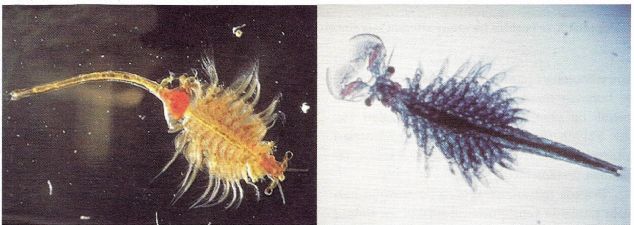 Picture: Female and male artemia ARTEMIA AND ITS USE Prof. Dr AtillaAlpbaz ARTEMIA sp. Artemia sp is a creature that grows in salt lakes. This creature has an important place in fish farming due to a special situation. Artemia eggs collected from lakes can be stored for many years. When desired, larvae can be obtained by putting eggs in salt water. These larvae can also be fed to other fish larvae as feed. Successful studies have been carried out in feeding the larvae of cultured fish in the first days. The place of this creature is important when feeding with larvae in sea bream and sea bass breeding in our country. Some algea. Rotifera and artemia larvae are main food at the beginning of cultivation of baby fish It is accepted that Artemia species have existed in the world for a hundred million years. For this reason, it is considered one of the rare creatures left from the dinosaur era. Eggs can maintain their vitality for many years in a dry environment. It is thought that the survival time of the eggs can be a thousand years. It has been proven by experience that eggs can survive for fifty years. Due to this feature, artemia egg can be stored for a long time. Its ability to be used as bait also provides great convenience in feeding juvenile fish. Artemia belongs to the crayfish family. It is an interesting creature with its three eyes. Two of these eyes are normal. The third eye can be defined as the naupli eye. Young fish have only naupli eye as one eye. The naupli eye disappears when the other two eyes are formed. Artemia has spread all over the world. They have the ability to live in salt lakes rather than fresh waters. They are loved and consumed by other living things as food. They cannot show reproductive potential in lakes containing fish. Besides, they can reproduce intensely in many lakes that are very salty. The species "Artemia franciscana" whose eggs are commercially marketed by "ROTIFER SU ÜRÜNLERİ" and found in Saltlake / America has an important place in our country. "Rotifers SEAFOOD", serves as a marketing representative in a bussiness named GSLA. GSLA produces artemia in Great Salt Lake in the United States. Positive results have been obtained as a result of the studies of this creature, which can breed for billions, in some salty areas. When the studies conducted in Vietnam on this subject were successful, studies on this subject were carried out in other countries. However, few have achieved positive results outside of Vietnam in commercial terms. Some studies are being done in China, but it has not met the needs of this country. GSLA Atemia use is also common In recent years, the price has increased due to the low harvest of GSLA artemia eggs. This situation led to the search for new resources. Meanwhile, Russian product artemias produced in Russia have entered the market, but their use is not very common in our country. The structure of these eggs is a bit coarser and more processing is required during hatching. It is necessary to apply with a chemical called activator. Artemia is produced from many lakes in Russia. Therefore, a good research should be done during the purchasing phase. The opening methods that should be applied according to the source should be followed. In addition, there may be situations where artemias collected from different sources are mixed and marketed. Its price is cheaper, but still some companies have not reached a certain standard level. It is possible to solve these problems in the following years. By the way, there are very cheap sales advertisements in the Chinese market on the internet. You should be very careful about this and should never be bought without knowing that it is a reliable company. We ask you to take these warnings into consideration because we are deceived, so to speak, in a product we bought from China. Artemia produces two types of eggs. Some of them are in a pouch and crack in a short time. Some eggs have a thick shell structure. These eggs are very resistant to environmental conditions. As mentioned in the introduction, they can stay alive for decades in a dry and dry environment. Commercially important are the eggs in this group. Artemia eggs start to create large stocks in the lakes from the autumn season. Collectors, who know this period, collect tons of eggs with special methods. They present the eggs to the market after various processes. In this regard, the most important lake in terms of productivity in the world is the large salt lake known as Great Salt Lake (GSL) in Utah. 2.5 million tons of salt is obtained from this lake annually. In addition, between 700 and 1500 tons of Artemia eggs are produced, depending on the year. This product has an important place in aquaculture. The great salt lake is 135 km long and 50 km wide. It is a lake that is approximately 5,500 km2 in size. Its maximum depth is around 10 meters. Normally it is 3-5 times saltier than sea water. It has a salinity between 11% and 28%. It contains very suitable conditions for Artemia. Because many plankton (especially Dunaliella) that are necessary for feeding Artemias find a large amount of breeding opportunity. Since there are no fish in the lake, Artemia finds a large area for breeding. The lake is also a bird paradise that has become a stop for migratory birds. An interesting hunting begins in the lake when the Artemia eggs are concentrated. Hunting in the lake is done with a government permit. A person holding a permit leaves a float in the area where Artemia eggs are collected. This buoy acquires the right to hunt in the 150 meter radius area around it. For this reason, companies compete to determine the place where the eggs are abundant in the lake and to reach this region before anyone else. Firms control the lake continuously with small aircrafts. When the pilot sees that there is an egg gathered somewhere, he informs his friends on land. Upon this news, they try to reach this area and release their buoys by speedboats before anyone else. If the company has more than one fishing permit, it may not bring other companies closer to the region by leaving buoys one after the other. After the buoy is released, the heavier moving fishing boats arrive. They turn the eggs collected on the surface with nets and take them to the boat. After this process, Artemias are brought to the facilities and presented to the market after various processes In recent years, around 2007. seven fishing companies in this lake have united and established a cooperative (GSLA). Artemia is now marketed from a single source. As we mentioned earlier, Rotifers makes this cooperative's representation in Turkey.
 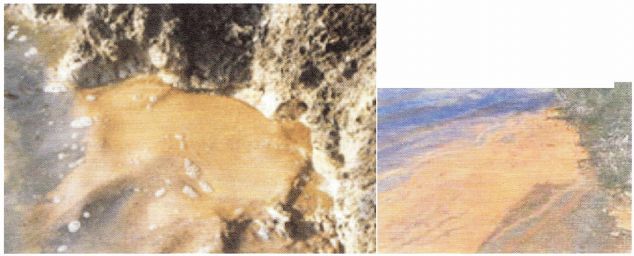 . Picture:(Top) Fish and shrimp larvae fondly consume Artemia larvae. (Bottom): Artemia can be gathered on the shores when the eggs are abundant. However, they are considered to be of poor quality
EGG QUALITY The most important issue in egg quality is the cracking rate. Egg hatching in 100 eggs indicates the amount of larvae obtained. In general, Salt Lake origin eggs contain around 270,000-280,000 eggs per gram. The classification made by considering the hatching rate of these eggs is presented below. 90% hp have app 255 000 NPG 85% hp have app 240 000 NPG 80 % hp have app 225 000 NPG 75% hp have app 210 000 NPG The cracking rate is expressed with the initials of the words hp (haching percentage). NPG refers to the number of live larvae per gram, taken from the initials of (nauplius per gram). For example, an artemia with 85-90% hp (cracking rate) contains approximately 270,000 eggs. The number of larvae to be obtained from these eggs will be approximately 250,000-260,000. Egg quality is the number of eggs per gram. As the number of eggs increases, the size of the larvae obtained from these eggs will be smaller. These small larvae produced are used to feed fish larvae with small mouth structures. For example, in the production of sea bass larvae, producers use Artemia of San Francisco origin for the first week. Artemias of San Francisco origin are used to feed fish larvae in the first week because they are smaller in diameter. For this reason, their prices are a bit high. Small structured eggs can also be obtained among the eggs obtained from the salt lake alone. There are 350,000 pieces in 1 gram egg of San Francisco origin. In samples with 90% hp, the number of larvae is around 300-320,000 NPG per gram. In those with 80% hp, the number of larvae is around 280,000. Micro Artemia production has decreased in recent years due to pollution in San Francisco Bay. Production studies with eggs transported from San Francisco to Vietnam have been cultivated successfully. Top quality micro Artemia is still produced in Vietnam by cultivation.
Analysis for Artemias of San Francisco origin: protein 60%, oil 24%, ash 4.4%, moisture 8.5% The content of salt lake origin Artemias is: protein 50%, oil 19% cellulase 1.7% Ash 6.1% and moisture 8%. For this reason, it is accepted that the nutritional value of Artemias originating from San Francisco is higher. USE OF ARTEMIA
Artemia eggs are collected from the lakes and placed in cold storage after processing. It is best to stock packed Artemias in +4 degrees cold storage. In this way, the vitality of the eggs is preserved much longer. Artemias are generally marketed in tin cans. Although these boxes are 1 pound (453 grams), they generally contain 425 grams of net Artemia eggs. It is not appropriate for people who use large amounts of eggs to use these small packages. Packages containing Artemia in quantities of 5-7.5 kg or more, depending on the production companies, can also be offered on the market. The buckets in which larval fisheries are marketed at 20 pounds contain a net 9.07 kg of artemia. There are many procedures during the use of Artemia. These are respectively: hydration, decapsulation, cracking, harvesting and enrichment. These operations are explained below.
HYDRATION
Action is required when using Artemia eggs. The more successful these operations are, the higher the utilization rate will be. Before the decapsulation and cracking process described below, hydration is performed. Before decapsulation, the eggs are washed with fresh water and left in fresh water for about an hour. This process is called hydration. If dry Artemia is treated without resting in water, the shell will not weaken properly. Problems may occur in the output power. Dry eggs absorb a lot of water. They absorb up to 140% of water within a few hours. After absorbing 60% water, vital activity begins inside the egg. It is understood that the soaking period is completed, when the eggs in the container and above the water do not stick to the edge of the container.
DECAPSULATION
In Artemia eggs, the shell is softened and the larvae are easily hatched. This process is called decapsulation. In Artemia eggs with a high rate of cracking, decapsulation is beneficial for some years, and in some years it is not necessary. It has even been observed to be harmful. For this reason, hatcheries using kilos of Artemia decide whether to decapsulate according to the Artemia source they use. The decapsulation process will help increase the output power for eggs whose output power is not very high, for example around 70-75%. Decapsulation is recommended in many publications. One must be very careful about this. Decapsulation is not required, especially in Artemias with high output power. For example, this process is not required for an egg with 90% cracking power. In our country, the use of Artemia with high output power is generally preferred. However, if a high output power is expected and a result that is 0 / 05-10 missing from the desired result is obtained, the output power should be increased by performing a decapsulation process. It is claimed that the decapsulation process is not applied solely to increase the output power. During decapsulation, the shell of the egg becomes thinner. Thus, the larvae can hatch without spending much energy. Thus, the nutritional value of the larvae is provided to be higher. With the help of decapsulation, an increase in hatching rate of around 10% can be achieved in eggs with low hatching rate.
There are two methods used for decapsulation.
CHLORINE METHOD In this method, 6% sodium hydrochloride solution is used or an industrial corine (11% sodium chlorine) solution is used. For small amounts of decapsulation, 15 g of soaked Artemia is added to 300 ml of 6% solution. It is continued for 3-5 minutes until the eggs turn an orange-brown color. Eggs taken out of solution are immediately washed with fresh water or seawater. It is washed in a 120 micron mesh sieve. The washing process is continued until the chlorine odor is eliminated and this takes an average of five minutes. After this process, normal cracking process begins.
CHLORINE / SODIUM HYDROXIDE METHOD
Sea water is used in this method. 50% sodium hydroxide (NaOH) and industrial 11% hypochlorite solution are used. When these two substances are combined, heat occurs. Therefore, it is necessary to be careful in application. Therefore, the materials used and the sea water must be cold. Thus, the heat effect that will occur is prevented. For the decapsulation of 100 g eggs, 15 ml of 50% NaOH, 550 ml of 11% chlorine and 800 ml of cooled sea water are used. This mixture is mixed with a magnetic stirrer and aerated frequently. At this mixing moment, there is a very strong foaming. Therefore, the containers used must be clean. This prevents the container from overflowing. The process continues for 3-5 minutes until the eggs turn an orange-brown color. After the process, it is quickly washed with fresh water or sea water in a 120 micron sieve and taken to the cracking process. After the decapsulation process is finished, it would be better to wash the eggs with 1% HCL for a minute. For this, 65 ml of 35% HCL solution is mixed with 6.5 liters of water and the desired HCL solution is prepared. Thus, the decapsulation process is terminated. For this purpose, sodium thiosulfate solution, which will be prepared weakly, can be used.
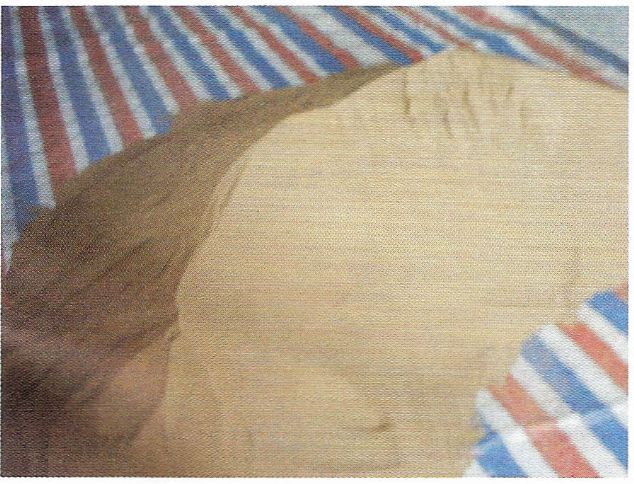 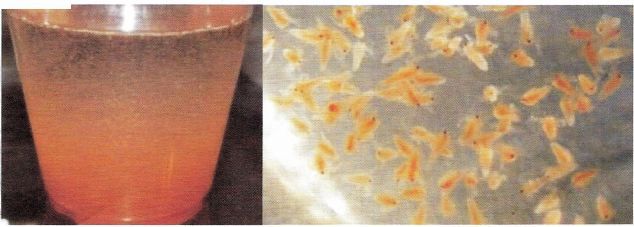 Picture:
(Top): Artemia eggs are very small and contain 280,000-300,000 eggs per gram.
(Bottom): Artemia larvae that have just hatched. As can be seen in the picture to the left, dense larvae are obtained from one gram of eggs.
CRACKING During the opening phase of Artemia, it is necessary to be careful about the following issues. TANKS The tanks where Artemia eggs will be hatched will vary according to the amount of eggs to be hatched. Conical tanks are the best in this regard.
WATER Very clean water should always be used. It should not be forgotten that Artemia eggs are an expensive product and very careful use is required. Artemias need to be washed with fresh water and kept in fresh water for one hour before they are placed in the cracking tank. This process is called hydration process and has been explained above. There are publications that recommend 1 liter water volume 2.5 g Artemia for cracking. In businesses that crack the most Artemia, up to 5 grams of Artemia per liter can be used. The amount of Artemia to be put into 1 liter of water should be 5 g for small applications and 2 g per liter for large-scale applications. This is recommended in some publications. In some publications, this amount is given between 2-4 grams.
VENTILATION It is very important that the oxygen level is at a good level. Ample ventilation should be applied. With this application, it is ensured that Artemias collapse and are constantly in motion. It may be beneficial to add a few drops of non-toxic defoamer to avoid excessive foaming on the water during over aeration. Silicone defoamers can be used for this purpose. The amount of oxygen should not be less than 3 mg / lt. Oxygen amount should be at least 3 mg / lt. The most appropriate one is 5 mg / lt.
PH It’s recommended to be between 8 and 9. Those who use a large amount of Artemia in this regard should ask the company they purchased the PH status to be used for each batch. If this issue is unknown, the ideal should be set to 8.5. Muriatric acid can be used to increase the pH level. During the opening of the artemias, if the PH level falls below 8, the pH can be increased by adding a little sodium bicarbonate.
SALINITY It is known that salinity between 0.12 and 30% does not cause trouble for optimal opening. For this reason, 025-30% salinity ratio is sufficient. Using sea water will be the most practical and convenient method. If a saltwater environment is to be created with salt, raw sea salt should be used.
DISINFECTION In some publications, disinfection is recommended. It does not need to be done when there is no abnormal situation. Chemicals will damage the shells of Artemia eggs when unnecessary disinfection is carried out. It is beneficial to disinfect all the containers used.
LIGHTING It is recommended to make an illumination between 1700-2500 lux. Natural lighting may also be sufficient. Lighting needs to be done around and above the tank. In short, lighting should be made from everywhere. This kind of lighting will help to increase the rate of cracking.
STOCKING Artemia eggs must be kept in a dry environment. Eggs sent from companies are in containers that do not receive light and do not contain moisture. If a bucket, a part of which has been used, is to be put back into the cold storage, the bucket should be closed very tightly. Cold storage is recommended to be between 0-6 degrees. The ideal is 4 degrees.
TEMPERATURE The optimum water temperature is 27-28 degrees. If it gets colder than 25 degrees, the rate of cracking will decrease. If the water temperature rises to 33 degrees, the development in the egg stops and there is no cracking. Especially for Artemia eggs of GSL origin, the water temperature should be high. The ideal is 28 degrees. It is said that the water temperature can be 22-24 degrees for the eggs of San Francisco origin.
CRACKING TIME When suitable water conditions are provided, the hatching time of the eggs is on average 18-24 hours. The processing status of the material used, the processing time after collection from the lake, and the stocking conditions may be effective. If there is no cracking at the desired rate, it is useful to wait for a while.
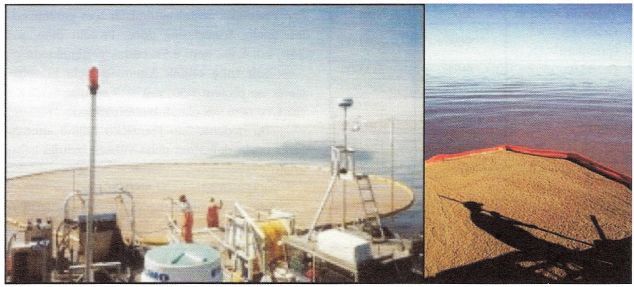 Picture: Artemia collection studies in Salt Lake. Artemias surrounded by a net are taken to the tanks on the boat and taken to the factory. It is then processed and released to the market.
HARVEST Cracking in Artemia eggs with 90% hp generally takes 22-24 hours. Sometimes this period can be a few hours longer. It would be beneficial to quickly separate the crusts from the larvae after cracking. As the shells do not have any feed value, their stay in the environment accelerates the growth of bacteria. Ventilation is stopped while the Artemia eggs will be harvested after hatching. Then it is waited for 10 minutes. During this time, the unloaded shells after cracking will accumulate on the water surface. Those that have not cracked will collapse at the bottom. With the light given to the middle part, free floating larvae will be collected in the light area of the tank. It is possible to collect the larvae from this place where they are densely collected, with the help of a siphon, in a sieve-like place made of plankton gland. If possible, uncracked eggs collected at the bottom can be cracked with a new study. After the hatched eggs are removed, 10-12 hours can be waited for the remaining ones to crack. It is helpful to make a calculation to see if the cracking rate is appropriate. For this, it is taken with the help of a pipette and counted on the counting table. The result obtained is multiplied by the volume of water, resulting in the number of larvae present. According to the amount of Artemia added, the number of larvae per gram is found. Thus, it is investigated whether the results of the cracking process are correct according to the material used.
SE-PART TECHNOLOGY INVE Aquaculture has launched new tools that to help farmers drive efficiency in hatcheries. The SEP-ART Tools are a sustainable solution designed to maintain quality nauplii, reduce losses and ensure safety for workers and the environment, according to a release from INVE Aquaculture, a subsidiary of Benchmark. Traditionally, Artemia nauplii are separated from cysts using a double sieve or a decapsulation method which can cause mortalities in the nauplii, quality issues and is often labor intensive. Decapsulation is also a chemical exothermic process resulting in the release of waste product and toxic gasses which can be a risk to the environment and operators. During the decapsulation process heat is also produced which can damage Artemia cysts. The newly launched tools are based on the Artemia SEP-Art technology produced by INVE Aquaculture in 2008. The SEP-Art technology consists of cysts covered with iron particles which are attracted to magnets leaving nauplii in the solution Available in manual, semi-manual and fully automatic, the tools are tailored to all hatchery sizes..https://www. 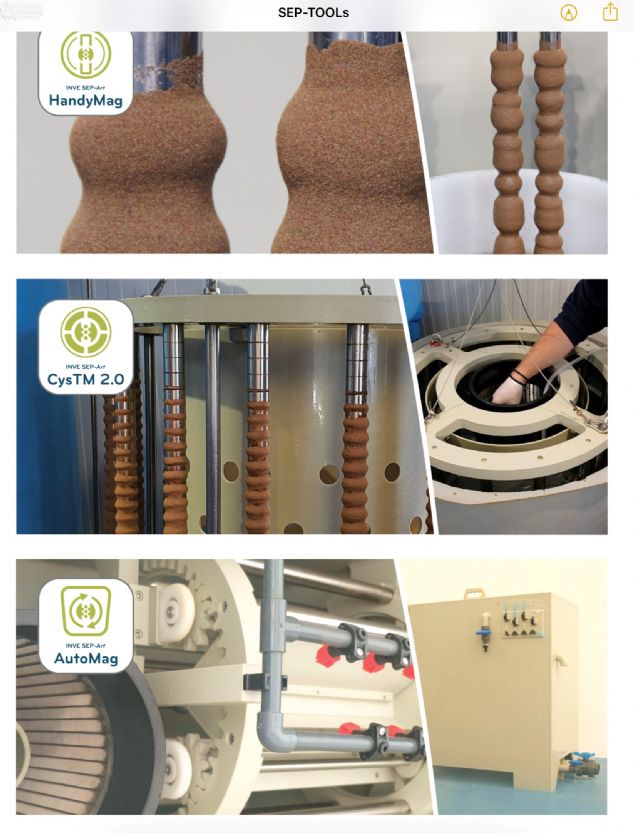
ENRICHMENT Enrichment is a process to improve the food condition of Artemia larvae. Since the Artemia larvae grow in size, it should be applied after the feeding period with Artemia. Or it should be applied when the larvae can consume 600 micron feed. The materials used in enrichment are generally composed of oil. They contain 60-90% oil. Besides, they contain some vitamins. They are rich in HUFA, EPA and DHA. In this regard, products produced by many companies are marketed in the market. Although there are many differences between them in terms of price, it should not be perceived as "the most expensive is the best". It is useful to examine the contents of the products and make a comparison. We can summarize the enrichment application of Artemia larvae to be used in sea bream and sea bass farming or in all marine fish farming as follows. All kinds of materials to be used, tanks, pipes, air stones, etc. should be thoroughly washed with detergent and clean water. It should be rinsed with plenty of water so that there is no detergent residue. Then all materials (hypocholoride) should be disinfected with chlorine (should contain 200mg of activated cholorine). All materials should be washed 1-2 hours after disinfection so that there is no chlorine odor. After this process, the tank is filled with sea water preheated to 25 degrees. With a sufficient amount of air stone to be placed in the tank, the water is ventilated at a moderate level. Oxygen level should not be less than 4 mg / lt. 0.5 gr active cholorine should be added to each liter of water in the tank and disinfected for 1 hour. Cholorine in the water is eliminated by adding 0.5 g of sodium thisulphate per 100 liters of water. The water temperature is controlled again and it is ensured that it is between 25-30 degrees. After this process, about 300,000 Artemia larvae per liter, Artemia larvae are transferred to the tank after hatching. (The ideal is to put 100,000-200,000 larvae per liter.) After this preparation, the enriching agent must be added to the water. For this purpose, 300 mg of enrichment should be added per liter of water. (Considering the package insert of the enhancer used, the recommended amount to be added to 1 liter of water should be considered.) Add a little water and mix it rapidly in the mixer for 3-5 minutes. The mixture obtained is slowly added to the tank and enrichment process is carried out. Normal lighting conditions are used as lighting. Although it is recommended to continue the enrichment period until the desired HUFA level is reached, this period may vary between 12 and 24 hours. As a result of enrichment, Artemia larvae, which are 450 microns in size at the beginning, reach approximately 600 microns after 12 hours and 800 microns after 24 hours. We can define these two stages as short-term and long-term enrichment. If long-term enrichment is to be applied, it may be necessary to add a second enrichment after 12 hours. What is important in this regard is to add around 300 mg of enrichment per liter. It is a product that can be used for this purpose and has an important market share among the enrichers marketed in our country, especially produced from natural algae. The usage tariff of ALGAMAC 3000 in powder form or ALGAMAC 3050 or red algamc which is have antastaxin (natural astaxhantin in red algamac is hemmetococus sp)in flake form, which is considered superior in terms of both cost and enrichment, is as follows. 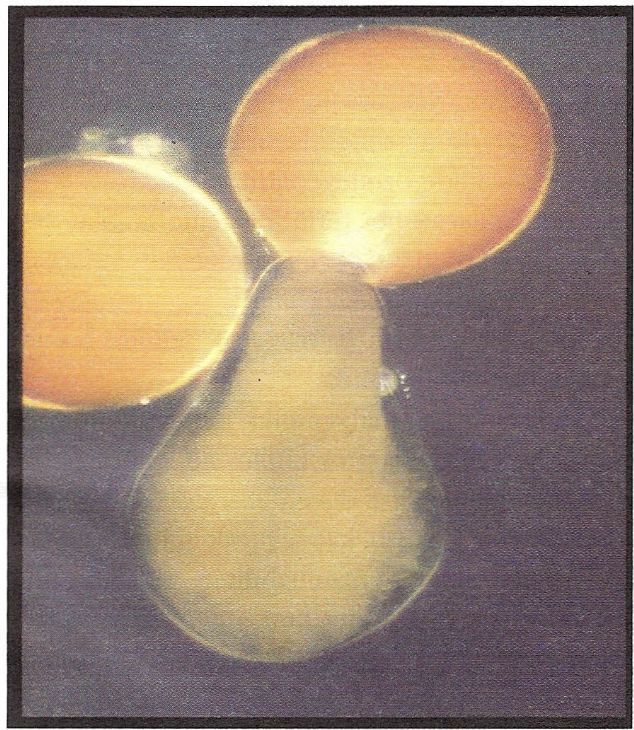 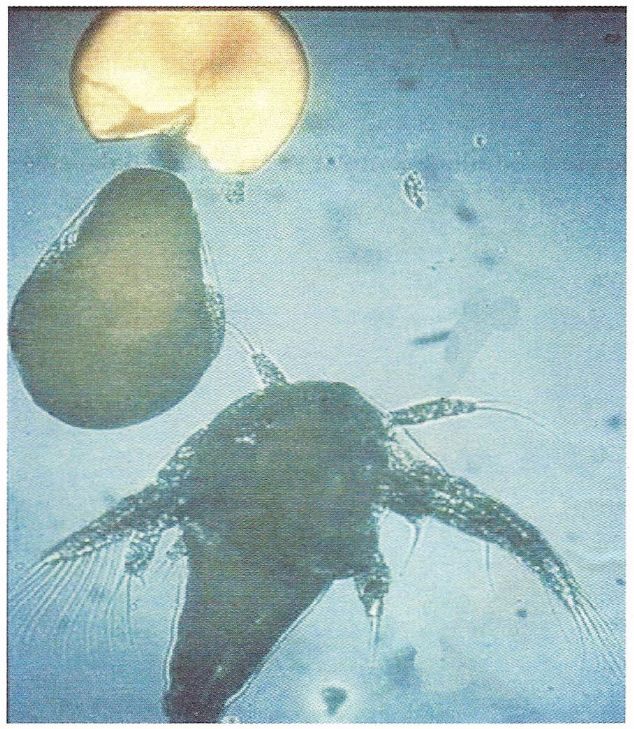 Picture: Larvae that have just hatched. Umbrella situation in the early stages of hatching on top. A freshly hatched Artemia at the bottom. METHOD OF USE ALGAMAC 3050 1- Take the amount you will use out of the cold storage one day before. The temperature should be in normal weather conditions. 2- Take the newly hatched Artemia into clean sea water. 3- One liter can hold up to 200-300,000 stocks. 4- The oxygen content of the water should be around 4-5 ppm. 5- For 100.000 Artemia per 5-liter, 0.2 g of algamac 3050 (3000) is calculated. 6- 30 gr in 1 liter of fresh water is put into the mixer. The water should be at room temperature. 7- The mixing process in the mixer should take about 2 minutes. 8- Thus, the product is divided into 6-8 micron pieces. 9- The foam formed as a result of mixing is thrown from the top. 10- The mixture is filtered through a 50-80 micron plankton cloth. 11- Algamac 3050 is given to Artemias and it should take 8 hours to feed Artemias. 12-Strong ventilation is applied during feeding. Oxygen level is monitored. It is ensured that the amount of oxygen is not less than 4-5 ppm. Liquid oxygen will help in this regard. 13.Artemia is harvested and used as fodder NOTE: If a higher level of DHA is desired in Artemia larvae, it should be fed again with 0.2 gr ALGAMAC 3050 account for 100.000 larvae. After a second enrichment process lasting 8 hours, you can use the fish larvae for feeding. SAMPLE: Let's say you use half a kg of Artemia eggs. If 85% hp is 500 grx280.000 ad / grx0,85 hp = 119 million larvae Enrichment can be carried out in a tank of approximately 500 liters for 250,000 larvae in one liter. If 0.2 g will be given to 100,000 larvae 120 million / 100,000 = 1200 for approximately 120 million larvae 1200x 0,2 gr = 240 gr 3050 will be used. Since 30 g of water will be mixed in 1 liter of water in the mixer, 240/30 = 8 liters of water should be used in the mixer. If the water capacity of the mixer is 2 liters, you will repeat this 4 times and you will dissolve 60 gr 3050 in 2 liters of water each time. Air is shut off first to collect the enriched Artemias. The larvae are washed with plenty of water so that there is no enrichment residue on them. If this washing is not done well, the oil that will mix with the Artemia larvae and the fish larvae tank will contaminate the water. This should be paid attention to. If death occurs during the enrichment phase, the cause may be a bacterium or there is a problem in the ventilation. Oxygen level dropped below 4mg / lt. It is understood that the necessary attention has not been paid to disinfection issues.
Enriched Artemia can be stored in 5-10 degrees, chilled environment. During this holding period, 2-6 million larvae can be stocked per liter. The vitality can be 100% in this environment for 24 hours. There will be no loss of energy or food since the metabolism of the larvae will slow down with this cold soaking. When the water rises to 25 degrees, vital activity will begin immediately. For this reason, after enrichment, it is better to cool the larvae until they are fed. 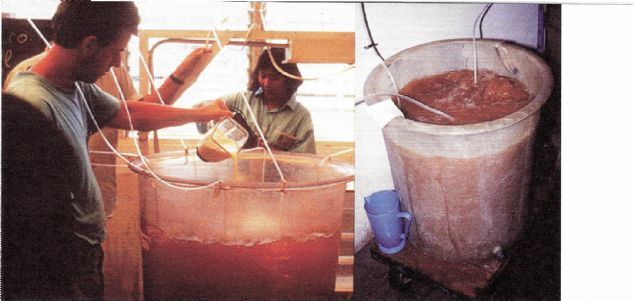 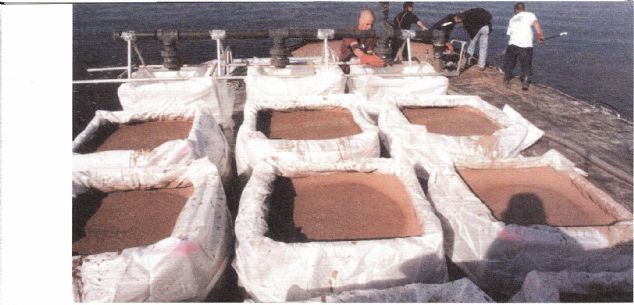 Picture: (Top) Enriching the Attemia (Bottom) Post-harvest view of eggs collected by the GSLA. |




